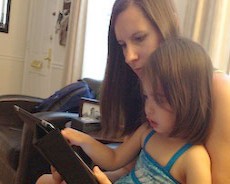 Until last year, I had a strong appreciation for Muppets, but limited knowledge of the role of children’s media in the 21st century. I was purely of the first generation of ‘Streeters — the generation whose episodes now come with a parental warning. But in March 2011, everything changed. While staying with my nephews in Maadi, a neighborhood of Cairo, Egypt, for a few months, I got a first-hand glimpse into some of the affordances of digital tablets and the way kids learn and play.
Until last year, I had a strong appreciation for Muppets, but limited knowledge of the role of children’s media in the 21st century. I was purely of the first generation of ‘Streeters — the generation whose episodes now come with a parental warning. But in March 2011, everything changed. While staying with my nephews in Maadi, a neighborhood of Cairo, Egypt, for a few months, I got a first-hand glimpse into some of the affordances of digital tablets and the way kids learn and play.
I quickly learned there is a new generation of mothers out there: the Digital Moms who have, on hand and on demand, various media devices for their children’s recreation and education. According to a study released by Razorfish and Cafemom, Digital Moms are gaining in the mainstream: an estimated 84 percent of U.S. moms are online and using gadgets. In November 2011, the New York Times reported that more parents preferred paper books to e-readers. Fastforward to Mother’s Day 2012 and it is a completely different picture. A staggering amount of the mothers polled on the site Techbargain.com — 91 percent — would rather receive an iPad than flowers. The survey did not discuss use, so we won’t know for certain whether the want is for the affordances to the whole family, or the ability to read 50 Shades of Grey wherever they are.
 In our house in Maadi, all iPads and iPhones (apparently, we are a Mac family) were primed with apps and videos for my nephews (this also led to the fun of explaining to dates later on why I had a bunch of “Mommy Apps” on my phone.) My sister-in-law used her iPad, along with old and new episodes of Sesame Street and the Electric Company (and full disclosure, some of Disney’s Little Einstein and Nickelodeon shows as well), to entertain and educate her sons, then ages 2 and 5. The videos not only provided the educational content they are renowned for, but also connected the boys to the U.S., allowing them to have some common ground with American friends when they return.
In our house in Maadi, all iPads and iPhones (apparently, we are a Mac family) were primed with apps and videos for my nephews (this also led to the fun of explaining to dates later on why I had a bunch of “Mommy Apps” on my phone.) My sister-in-law used her iPad, along with old and new episodes of Sesame Street and the Electric Company (and full disclosure, some of Disney’s Little Einstein and Nickelodeon shows as well), to entertain and educate her sons, then ages 2 and 5. The videos not only provided the educational content they are renowned for, but also connected the boys to the U.S., allowing them to have some common ground with American friends when they return.
The 5-year-old instantly identified with Elmo and Abby and all the children like himself who are learning reading, writing, and arithmetic. His younger brother reacted to “Ses!!!!!” on a much more visceral level. The characters were the same, even though he was now living in a completely different world. Cookie Monster, he explained, eats American food when he watches the U.S. version and Egyptian food when he watches Alam Simsim (the Arabic version ofSesame Street which he and I watched to help us learn Arabic). The tablet helped keep him aligned with both his own-but-far-away home and learn about the new culture he was currently living in.
“Digital media has the power to play a positive role in [children’s lives] and provide unique, entertaining and educational experiences,” notes Cooney Center digital industry expert Carly Shuler.
As Digital Moms increase in the mainstream, so does their children’s access to digital media and emerging technology. Yep, it’s the pass-back effect again. This effect is rampant in the U.S. — our market is the third largest digital market after India (2) and China (1), with 105.8 percent of the population mobile subscribers. As Shuler establishes in iLearn II, almost 50 percent of the apps in Apple’s education vertical are geared at education elementary and primary school children. With women controlling “$12 trillion of the overall $18.4 trillion in global consumer spending,” these app designers are targeting an influential market segment willing to purchase apps for children. The greater exposure to 21st century skills families have, the more their children benefit in terms of formal and informal education.
A close friend told me that she uses her iPad stealthily as a reward system. While her two sons, ages 3 and 6, can “read” by themselves on the gadget, she interacts over chess or games as a reward. “I see these skills — navigating the content, being interested in my use and how [the iPad] works as crucial to what they will need to be successful as adults,” she told me. “That is, until the interest in how it works leads to them looking at the insides.” And in my family, we had a 2-year-old who could distinguish between a single (talking) bacterium and many bacteria (a topic I apparently missed in school), and a 5-year-old greatly interested in how things work.
So props in the successful integration of digital media go to the Digital Moms out there (with recognition to non traditional care givers and fathers, most of my observances were of moms interacting), who are increasingly exposing children, and very young children, to tablets and e-readers, fostering important 21st century skills and an increase in interest in STEM topics.
My nephew and sister-in-law recently skyped to say how much they were enjoying playing Electric Racer together — a game designed to be played by parent and child while fostering the child’s reading and spelling skills. Like my friend, my sister-in-law uses this game is used as a reward or treat. Digital media has allowed moms to incorporate informal learning a lot more seamlessly into a daily regime. It has also allowed for the generation of moms, who now cough into their fist when asked their age, to overcome the STEM chasm from education in the 1970s to now. A little time with digital media, and my sister-in-law and I had expanded our knowledge base exponentially — we could now answer why planets rotate, how volcanoes work, teach the electric slide to five year olds (he was convinced it was not a dance but how electricity traveled; I maintain this dance is a life skill of its own) and even construct a very popular baking powder volcano.
Digital media allows parents and children to replicate, enhance and extend the pleasure of reading a traditional book together. Shuler shows that as characters cross mediums, so does the learning. “I love The Monster at The End of this Book, as we can read the eBook on the iPad and then can also read the traditional book.” Additionally, because of Paula’s age, Shuler and Paula are engaged in a lot of the new co-viewing, on iPads and iPhones. “[Paula] can certainly play with traditional toys alone (like big Legos or food play), but at this point digital media is a together activity,” she said. “Plus, she is very interested in testing what can float these days, and I don’t want my iPad to end up in the toilet!”



